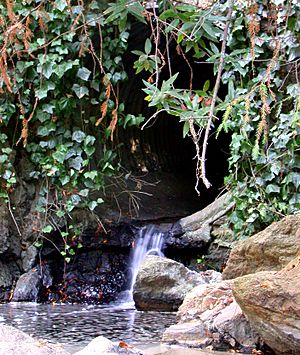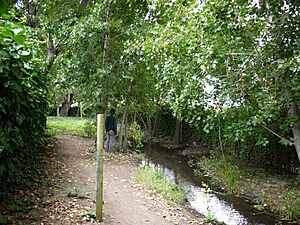Temescal Creek (Northern California) facts for kids
Quick facts for kids Temescal Creek |
|
|---|---|

Temescal Creek as it comes aboveground at Temescal Regional Park
|
|
| Country | United States |
| State | California |
| Counties | Alameda County |
| City | Oakland |
| Physical characteristics | |
| Main source | Montclair District, Alameda County, California 37°50′34″N 122°12′09″W / 37.84278°N 122.20250°W |
| River mouth | culvert toward San Francisco Bay Oakland, Alameda County, California 37°50′2″N 122°17′42″W / 37.83389°N 122.29500°W |
Temescal Creek is a main waterway in Oakland, California. It flows from the hills of Oakland all the way to San Francisco Bay. This creek has played a big role in the history of the area.
Contents
What's in a Name? The Story of Temescal
The word "Temescal" comes from an old language. It is from the Nahuatl word temescalli. This word means "sweat house." The Nahuatl language was spoken by the Mexica people of Mexico.
The creek got its name when it became part of a large ranch. This ranch was called Rancho San Antonio. People believe the ranch owners saw structures along the creek. These structures looked like sweat houses. Native people called Ohlone lived along the creek. They might have built these structures.
Where Does Temescal Creek Begin?
Temescal Creek actually starts as three different streams. These streams are called "forks." They begin in the Berkeley Hills in northeastern Oakland. This area is also known as the Oakland hills. The hills are part of the Pacific Coast Ranges.
The three forks come together in the Temescal district of Oakland. From there, the creek flows west. It crosses through Oakland and Emeryville. Finally, it reaches San Francisco Bay.
The North Fork: A Creek with Many Names
The north fork of Temescal Creek changed its name over time. In the mid-1800s, it was called "Harwood's Creek." This was named after William Harwood. He was a retired sea captain. He used to graze his animals in the canyon nearby.
Later, in the early 1900s, it was renamed "Claremont Creek." This new name came from a housing development. Today, this area is known as the Claremont district.
The Middle Fork: Flowing Underground
The middle fork of Temescal Creek flows through Temescal Canyon. Much of this fork now flows underground. It runs beneath a large freeway. This freeway leads to the Caldecott Tunnel.
This middle fork joins the south fork at Lake Temescal. Before the tunnel was built (1934–1937), this fork flowed into the lake. There was a bridge over its inlet. Today, that inlet is filled in. A large concrete wall stands there instead.
The South Fork: From Hills to Lake
The south fork starts in the northern part of Oakland's Montclair district. It flows southwest out of a canyon. This canyon is in the hills next to Thornhill Road. Then, it turns sharply northwest. It follows a valley formed by the Hayward Fault.
This south fork then flows into Lake Temescal. Lake Temescal was a natural sag pond. A sag pond is a small lake formed in a depression along a fault line. In the 1800s, a dam was built. This dam made the lake bigger. It was used as a reservoir to store water. Today, Lake Temescal is a public park.
Temescal Creek's Journey to the Bay
After leaving Lake Temescal, the creek continues its journey. It curves west around the Rockridge district of Oakland. Here, it meets the north fork (Claremont Creek). This meeting point is near Forrest Street and Miles Avenue. It is also next to the Grove-Shafter Freeway.
The creek then flows above ground for a short distance. It runs parallel to Claremont Avenue. Then, it goes into an underground pipe (culvert). It crosses Telegraph Avenue. Around 47th Street, it turns west again. From there, it flows directly toward San Francisco Bay.
The Mouth of the Creek: A Place of History and Nature
Temescal Creek is a perennial stream. This means it flows all year round. Because of this, early settlers found it very valuable. At the creek's mouth, the native Ohlone people built a large mound. This was the Emeryville Shellmound. It was made of shells and other things. It was the biggest shellmound on the San Francisco Bay shoreline.
When the area was part of the Peralta's Rancho San Antonio, the creek's mouth was a busy spot. It was a landing place for the ranch. Cattle and animal hides were loaded onto ships here. Animals were slaughtered in this area until the early 1900s. This part of town became known as "Butchertown."
Wildlife in and Around the Creek
It is thought that rainbow trout once lived in Temescal Creek. However, building cities and damming Lake Temescal caused their numbers to drop. Old discoveries show that coho salmon also likely lived in the creek. The Emeryville Shellmound also has remains of beaver.
Temescal Creek Today
Today, much of the creek in the flat areas flows underground. It runs through culverts. But many parts of the creek above Lake Temescal are still open.
In 2000, a part of the creek in Emeryville became open to the public. This happened after an old paint factory building was torn down. Now, Temescal Creek flows in an open culvert. It runs through the Bay Street Mall development. This spot is very close to where the Emeryville Shellmound once stood. There is a small park here. It shares information about the creek and the Ohlone people.
At Shellmound Street, the creek goes back into a culvert. This culvert takes it to San Francisco Bay. The creek's path here is now straight. But long ago, it used to bend south. It entered the Bay near where the IKEA store is today. Near its mouth, Temescal Creek flows through concrete channels.
The very end of Temescal Creek, where it meets San Francisco Bay, is affected by the tides. This area has mudflats and marshland. In the past, both sides of the creek in Emeryville were part of the Bay's tidal floodplain. This area was filled in with dirt and other materials from about 1900 to the 1970s.


